It’s that time of year again. Most of my peyote plants have flowered freely all through summer and now the eagerly awaited results, the fruits, are appearing (many of my plants are still flowering so I’m hoping for a good seed harvest this year ;-)
Fortunately the majority of my coldhouse grown Trans-Pecos peyote plants (Lophophora williamsii var. echinata) survived this winter’s harsh frost (contrary to my “regular” Lophophora williamsii growing in the same unheated greenhouse – most of these plants succumbed to the frost).
Trans-Pecos peyote with fruit
The first fruit appeared on one of the surviving Trans-Pecos peyote plants only a few days ago. I’m looking forward to growing these seeds as the parent has a proven record of frost hardiness and I expect this trait to be inherited by its offspring (I’m using the singular “parent” as I assume this fruit to be the result of selfing; it only contained two seeds). Hopefully many of the cold grown Lophophora williamsii var. echinata plants will set fruit during the next couple of months ;-)
Trans-Pecos peyote with fruit, top view
I’ve been made aware that my use of the echinata epithet is not entirely clear. To clarify, I’m using it in the sense of Del Weniger – others, e.g. Backeberg, are incorrectly (IMHO) using echinata to describe what seems to be diffusa.
In his book Cacti of the Southwest Del Weniger describes L. williamsii var. echinata as being a larger, tougher form of the species, having heavier and larger stems and not clustering to any marked degree (possibly with a higher mescaline content also). Furthermore the echinata variety is described as being much more tolerant to extreme temperatures, both hot and cold (Weniger writes: “This form is found growing on dry, exposed hillsides of the Big Bend where the lower Rio Grande Valley form would be burned to a crisp. It can also survive the much more severe cold of the Big Bend. I have several times had the smaller form from south Texas freeze in San Antonio, while this form growing in the same bed showed no ill effects”). The range of the echinata variety is given as “Northern Mexico, extending from Chihuahua and Coahuila into the Texas Big Bend in lower Brewster County”.
Trans-Pecos peyote fruit, close-up
I have to admit that I find it rather difficult to clearly distinguish the echinata and regular williamsii forms based on morphology alone, especially young cultivated plants. So I rely heavily on locality information when buying seeds and to play it safe I prefer material originating from the Trans-Pecos region of Texas, the northernmost extreme of the Lophophora genus’ range.
But as my horrible experience this winter showed the echinata variety (in this case Lophophora williamsii var. echinata JJH 8608293; Pecos River area, Val Verde County, Texas) definitely seems to be more frost hardy than the regular williamsii variety.
Thursday, July 22, 2010
Trans-Pecos peyote with fruit – it’s an echinata!
Wednesday, April 28, 2010
The power of grafting – 6th anniversary
A week ago my grafted Lophophora williamsii (SB 854; Starr Co, Texas) celebrated its 6th anniversary sitting on top a sturdy Trichocereus pachanoi stock. The plant was grafted as a tiny seedling and in 6 years the main head has grown to a width of approximately 8 cm (~3.2'') – the 3 largest offshoots are 6 cm (~2.4'') wide each. The main head seems to have stabilized at 8 ribs while the largest pups are in transition from 5 to 8 ribs.

Lophophora williamsii graft, top view
The last couple of weeks the plant has “popped out” fruits resulting from last years late flowers. This season’s first flower appeared a couple of days ago and was promptly (self-)pollinated – according to previous experience this should result in another fruit in 7-8 weeks time.

Grafted Lophophora williamsii, first flower of the season
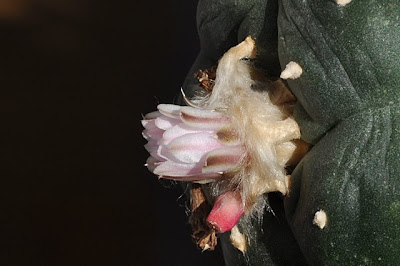
Lophophora williamsii flower and fruit
I’ve already harvested more than 120 seeds from this plant alone this season. As this variety of Lophophora williamsii is not particularly frost hardy I’m not sure if I’ll start all these seeds as the seedlings will have to go to my coldhouse – maybe I should set up a “swap shop” instead ;-)

Lophophora williamsii fruits
I’m wondering for how long the Trichocereus pachanoi stock will be able to support the rather large Lophophora williamsii scion. This is my oldest graft so I have no experience to rely on regarding the actual longevity of Trichocereus stock plants; I guess time will tell.

Lophophora williamsii grafted on Trichocereus pachanoi stock
For comparison you can check the posts on the same graft as one, two, three, four, and five years old.
Wednesday, April 21, 2010
The killing frost – life goes on
As mentioned in two previous posts (available here and here) this winter was extremely cold and killed off large parts of the collection I grow in an unheated greenhouse. Now spring is comming and the surviving plants are getting ready to move on.
Lophophora williamsii var. echinata with fruit
Most of my Trans-Pecos peyote plants (Pecos River area, Val Verde County, Texas; JJH 8608293) made it through the winter and is now setting fruit as if to herald the beginning of the comming growing season. If you look closely you’ll even notice a few flower buds.
Trans-Pecos peyote with budding flower
The Trans-Pecos peyote is also known as Lophophora williamsii var. echinata and is more cold-hardy than other varieties of L. williamsii
My Epithelantha micromeris plants (near Belen, New Mexico; SB1327) are also busy securing the next generation.
Epithelantha micromeris with fruit, top view
I’m getting increasingly infatuated with Epithelantha - you can’t but love the complex spination and the almost shocking pink fruits ;-) As Epithelantha has also proven to be an extremely cold hardy genus I’ll probably add more of these plants to my collection in the future.
Epithelantha micromeris with fruit
I am growing these plants at my summerhouse and not seeing them as often as I could wish. Unfortunately this also means that I miss a lot of the flowers including those of the Normanbokea valdeziana and Acharagma roseana pictured below.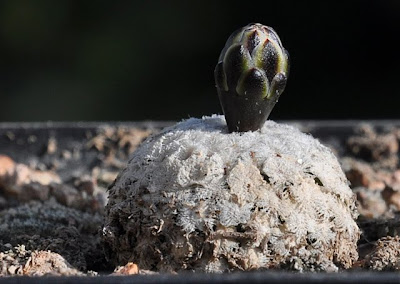
Normanbokea valdeziana about to flower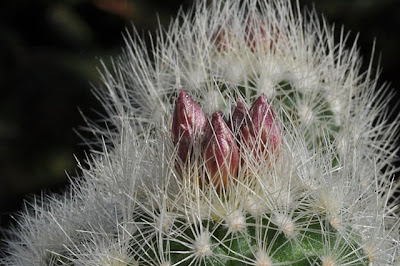
Acharagma roseana about to flower
Fortunately fruits are more persistent than flowers giving me the opportunity to enjoy sights like the orange-red berries of Escobaria missouriensis (Mesa County, Colorado; SB204)
Escobaria missouriensis with fruit
My Maihuenia patagonica are thriving after the winter but not exactly flowering or setting fruit. I don’t have much experience growing Maihuenia - I originally fell for Maihuenia poeppigii but being a completist I ordered M. patagonica seeds as well. All the M. poeppigii plants succumbed to the frost this winter while the M. patagonica plants only suffered a few casualties. I'm not sure I’m treating the plants right, though, as they are growing strangely lanky, far from the dense, clustering habit I have seen in pictures (and the plants are getting plenty of light).
Maihuenia patagonica
And now for something completely different.
My summerhouse is located on the west coast of Denmark overlooking the North Sea. This weekend the Sun set in a sky looking much more orange than usual, and slightly diffused as by a thin haze. 
The Sun setting in a haze of ashes from the Eyjafjallajökull eruptions
I take this to be caused by the Eyjafjallajökull volcano eruptions that have been sending a vast, invisible plume of grit drifting over Europe and kept most of European airspace shut down for several days. Of course one could imagine that a sunset like this was caused by a thin layer of clouds, but I have enjoyed hundreds of sunsets from my terrace and never seen anything like this before.
Sunset with a diffuse halo of refracted light – probably caused by Eyjafjallajökull ashes
On a different note, the Eyjafjallajökull volcano eruptions almost got me stuck in Amsterdam (not the worst place to be stuck in, by any means ;-) I and a colleague were supposed to have flown home in the late evening of April 15, 2010 – but as we watched more and more flights getting canceled and increasing parts of the north-western European airspace being closed down we agreed to rent a car. So in the early afternoon we set out on a long drive home – which in hindsight was an extremely wise decision as Danish airspace is only opening again today ;-)
Sunday, March 21, 2010
Acharagma roseana – flowers and fruits
To be honest, Acharagma roseana plants are not particularly ingratiating – the flowers are not breathtaking nor is the spination stunning. To me, the attraction of A. roseana lies in its close relationship with Lophophora and Obregonia, making it an obvious candidate for hybridization experiments.
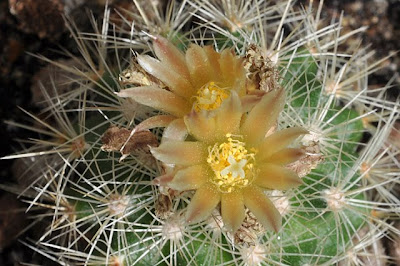
Acharagma roseana flower with pale yellowish tepals with brownish pink midveins
Gene sequence studies by Butterworth et al. (2002) suggest that Acharagma belongs in a well-supported taxonomic clade with Lophophora and Obregonia. They sum up their results as follows:
LOPHOPHORA CLADE. Although there is strong support for this clade (87% bootstrap, 5 decay steps), few morphological features unite this clade. All members have napiform or carrotlike tap-root systems, although these features are also found in other members of the tribe.
The two species of Acharagma have been a source of taxonomic confusion. […] The rpl16 intron data suggest the removal of these two species from Escobaria, placing them in a well-supported (bootstrap 87%, decay 5) clade containing Obregonia and Lophophora, the latter shown to be polyphyletic based on this topology.
(the closing remark on Lophophora being polyphyletic is an interesting statement in its own right, but that’s a whole other story)

Acharagma roseana flower with pink tepals with darker red-tinged midstripe
In The New Cactus Lexicon, Hunt describes this species as Acharagma roseanum - I’m not sufficiently well-versed in the Latin language to say which form of the name is correct, but according to this site on botanical Latin the specific epithet must match the genus name in gender. As Acharagma is from the Greek a, without, charagma, groove (the gender of which, according to Hunt, is neuter) this would warrant the “-um” ending. I’m a firm believer in applied laziness so I’ll stick to the (apparently erroneous) “-a” ending for a wee bit longer and avoid having to re-label my plants ;-) Hunt accepts two subspecies: ssp. roseanum and ssp. galeanense, the latter having more spines and slightly larger, cylindrical bodies, compared to the egg-shaped body of the typical form.

Comparison of the two different color forms of Acharagma roseana flowers
The Acharagma roseana plants featured in this post were started from seed in 2005 and flowered freely last summer. As mentioned I would like to use these plants for hybridization experiments with Lophophora but I still need to come up with a good protocol for avoiding self-pollination. The locality information for these specific plants is: LX 578; Ramon Arizpe, Coahuila - “Ramon” should probably read “Ramos” but I'll stick to the information from the vendor’s seed list.

Acharagma roseana with fruits
Like most other parts of Acharagma roseana the fruits are not showy either. They are an inconspicuous yellowish green color, but have a surprising, not unpleasant, tart taste reminiscent of gooseberries.
The plants grow in my unheated greenhouse and I hope they survive the month long cold snap that is just now loosening its grip of Denmark.
Monday, March 15, 2010
Echinocereus engelmannii v. armatus - flower and fruit
My Echinocereus engelmannii v. armatus (Joshua Tree National Park, California) flowered for the first time in the late spring of ‘09.
Echinocereus engelmannii v. armatus flower, close-up
The flower was beautiful with bright yellow anthers, a mesmerizing green stigma, and petals ranging from intensive pink to almost crimson at the center of the flower.
Flowering Echinocereus engelmannii v. armatus
The plant easily lives up to its varietal name - even the flower stalk is heavily armed with spines, protecting the ovary and the coming fruit.
Echinocereus engelmannii v. armatus flower armed with spines
I hand-pollinated the flower and two months later the plant bore fruit. This is the only mature Echinocereus engelmannii v. armatus in my collection and no other Echinocereus plants flowered at the time so my E. engelmannii v. armatus seems to be self-fertile. Time will tell if the seeds are viable.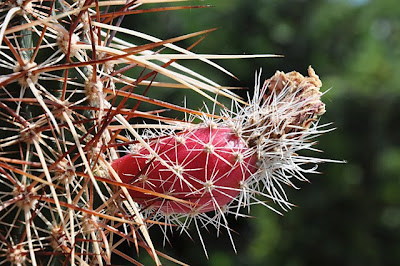
Echinocereus engelmannii v. armatus with fruit
Echinocereus engelmannii v. armatus with fruit, top view
Tuesday, February 09, 2010
Gymnocalycium calochlorum with fruit
I have only one Gymnocalycium calochlorum (Mina Clavero, Córdoba, Argentina) plant in my collection and it flowers freely every summer (I’m not sure if this should be put in the past tense as I’m uncertain if the plant survives this winter’s hard frost; the photos in this post are all from the summer of ‘09).
Gymnocalycium calochlorum with ripe, split fruit
The last time the G. calochlorum plant flowered I self-pollinated it and as the pictures show my efforts (as well as the plant ;-) bore fruit. My experience with Gymnocalycium is very limited and I don’t know if these plants in general are self-fertile – anyway, this one bore fruit and the coming spring will show if the seeds are actually any good.
G. calochlorum with ripe fruit and newly pollinated flower
I’m pretty certain that the seeds are the result of selfing – of course I can’t say for absolutely sure but I hand pollinated the flowers and none of the (very few) other gymnos in my collection were flowering at the time. Theoretically the seeds could be the result of some freak hybridization but that doesn’t seem very plausible, as most of the other cacti in my collection are of North American origin and not closely related to Gymnocalycium at all.
Gymnocalycium calochlorum fruit with exposed seeds
I pollinated two flowers that both set fruit. The last fruit is still growing on the plant.
Thursday, April 23, 2009
Spring awakening in the coldhouse
All of the photos in this post were taken at the beginning of April to illustrate some of the spring activity in my coldhouse. The plants have been kept dormant all through winter and received their first drink of water only a few days before these pictures were shot.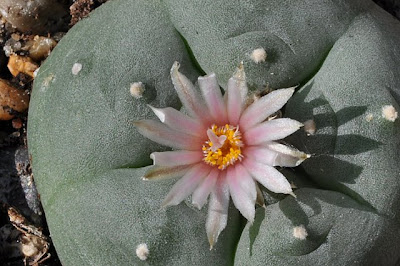
Flowering Lophophora williamsii (El Huizache, San Luis Potosí)
The first plant I want to show off is a flowering Lophophora williamsii grown from seed originating from the El Huizache, San Luis Potosí, Mexico population (the population Anderson assigned as the neotype for the species). These plants are from a more southerly location than the ones I'm usually growing and I'm happy to see they are coping so well with the cold conditions during winter. I was getting used to thinking of all L. williamsii varieties as self-fertile but according to the Cactus Conservation Institute, greenhouse breeding experiments by Bohata and colleagues in the Czech Republic and by Köhres in Germany have shown that plants from the El Huizache population are self-sterile and therefore obligate outcrossers (leading one to suspect a great deal of genetic diversity within plants from this population – in contrast to the self-fertile populations that have little to no genetic diversity among individuals as they outcross very little). 
Lophophora williamsii (El Huizache) flower with long style
The flowers of the El Huizache plants also seem to have a very long style that raises the stigma well above the stamens, making it hard, if not impossible, for the plants to reproduce without the help of a pollinator.
Bumble bee having fun with a Lophophora williamsii flower
Speaking of pollinators a bumble bee visited while I took these pictures – unfortunately only this one Lophophora flowered at the time making it impossible for the bee to fertilize the plant. The bumble bees that are active in early spring are huge; I don't know much about bees but am told that these large slow individuals are queen bees looking for nectar and pollen to feed their newly hatched brood.
Lophophora williamsii (SB 854; Starr Co, Texas) with fresh fruit
One of the Lophophora williamsii (SB 854; Starr Co, Texas) plants that I recently repotted has spawned a fruit. This variety of Lophophora williamsii is self-fertile to an extent where it happily sets seed if you just shake the flower a bit.
Flowering Acharagma roseana (LX 578; Ramon Arizpe, Coahuila)
My Acharagma roseana plants (LX 578; Ramon Arizpe, Coahuila - “Ramon” should probably read “Ramos” but I'll stick to the information from the vendors seed list) are coming of age. The plants were started from seed 4 years ago and are all ready to flower, displaying a wealth of flower buds. Only one, shown in the picture above, flowered when I took the pictures. Unfortunately it will be a while before I can visit my summerhouse (and coldhouse) again – I hope at least a few of the flowers will be saved for then. My Echinocereus reichenbachii plants are also growing a multitude of buds, getting ready for a flower fest I would hate to miss.
Frost damaged Matucana madisoniorum
Until now I have focused entirely on the success stories but a few of my plants didn't like being without heat during winter. My Matucana madisoniorum definitely didn't like the cold conditions (even being wrapped in multiple layers of horticultural fleece). The plant is heavily marked by the experience but survives.
I also lost a few plants: a couple of Carnegia gigantea (saguaro cactus), a Cylindropuntia bigelovii (teddy-bear cholla), and a Cylindropuntia tunicata (thistle cholla); I managed to save cuttings of the chollas though. These plants were kept out on the terrace all summer and I probably left them out for too long, exposing them to the autumn storms so the plants were not able to dry out completely before winter. I'm especially sad about the Carnegia gigantea plants as they were great specimens and are now completely reduced to mush.
Tuesday, April 21, 2009
The power of grafting – 5th anniversary
Five years ago today, I grafted a tiny Lophophora williamsii (SB 854; Starr Co, Tx) seedling onto a robust Trichocereus pachanoi stock. The Lophophora scion has since grown considerably – the main head is approximately 8 cm (~3.2'') wide; the total width including the offshoots now exceeds 14 cm (~5.5'').

Lophophora williamsii grafted onto Trichocereus pachanoi stock
This growing season the plant hasn't flowered yet but one of the “pups” (new offshoot stems) will do so within days as is evident from the next picture.

Flower bud and red spider mites
Unfortunately not only the plants are returning to life after their winter hibernation – the dreaded red spider mites are also fully active again (you should be able to spot at least four mites in the photo above) so the fight is on once more.
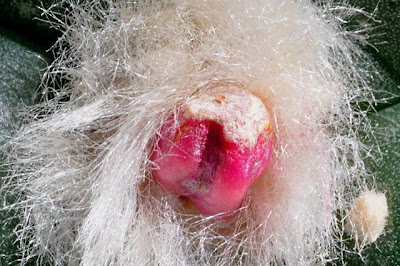
Ripe Lophophora williamsii fruit
Even though most of last year's fruits have long since ripened (and been harvested) the odd fruit is still showing. A plant this size gives hundreds of seeds each year making it a virtual seed “factory”.

Lophophora williamsii - rib count increasing?
The plant seems set on increasing its rib count beyond 8 – if I'm lucky it will not be content with growing just a few more ribs but go straight for the next number in the Fibonacci sequence, 13. The more ribs the merrier as it means more areoles and consequently more flowers and seeds.
The main head of the grafted Lophophora williamsii has grown 14 pups (15 if you also count a pup's pup – I guess you could call that a grandpup ;-) and has reached a size where it needs to be repotted soon.
For comparison you can check the posts on the same graft as one, two, three, and four years old.
Friday, October 03, 2008
How soon after your Lophophora flowers can you expect a fruit?
I was asked this question in a comment a while ago. I could not give an answer that was more precise than flowers pollinated early in the growing season would set fruit later the same year so I decided to investigate the question further. 
Freshly pollinated flowers marked with yellow cotton
Friday July 18 I marked 5 freshly pollinated flowers on my grafted Lophophora williamsii (SB 854; Starr Co, Texas) with yellow pieces of cotton - the cotton was attached to the spent flowers using nail polish. The flowers were all pollinated 1 and 2 days prior to being marked.
All I had to do now was lean back, relax, and wait for the fruits to pop out.
Wednesday September 10 – less than 8 weeks after pollinating the flowers – all 5 fruits had appeared.

Lophophora williamsii fruits

Lophophora williamsii fruit up close
The first fruit (in the right hand side of the photo below) appeared more than a week earlier than the others and consequently looks a bit withered.
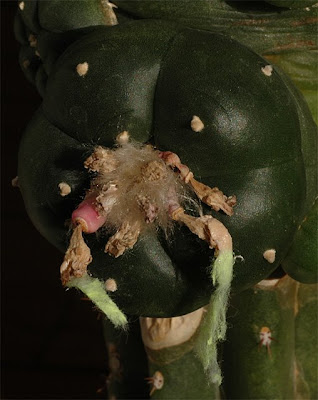
Offset with fruits

Another offset with fruit
So a more precise answer to the question above is that you can expect your Lophophora williamsii plant to set fruits within 7-8 weeks after pollination. At least that is the case for a grafted plant in good growth.
Tuesday, September 30, 2008
Fruiting Epithelantha micromeris, take two
A few weeks ago I posted on my fruit bearing Epithelantha micromeris (SB1327; near Belen, New Mexico) plants. The color of the fresh fruit is a bright pinkish red that changes to a deep, warm, saturated blood red color as the fruit dries. 
Epithelantha micromeris with dry fruits
In close-up the Epithelantha micromeris fruits are strangely reminiscent of small (weirdly colored ;-) cacao pods.
Close-up of dry Epithelantha micromeris fruits
When the last rays of the setting autumn sun shine on the fruits they assume an out of this world, glowing warm red color. I tried to capture it in the photo below but it doesn't quite do justice to the shimmering, radiant quality of the color (as should be evident by now I'm a sucker for the amazing palette of red nuances displayed by these little fruits ;-)
Fruits lit by the setting sun
Monday, August 11, 2008
Coldhouse grown Lophophora williamsii - the next generation
Four years ago I started my first batch of coldhouse grown Lophophora williamsii (SB 854; Starr Co, Texas) from seed. I've lost a few plants to frost during the years but the survivors have coped surprisingly well, enduring the Danish winters in an unheated greenhouse without problems (that being said, I still worry a bit for the plants every winter ;-).
Flowering Lophophora williamsii (SB 854; Starr Co, Texas)
The plants are now old enough to flower and have been doing so freely all summer. The above photo was taken late June and today the plants are still flowering.
I have pollinated as many flowers as possible - if more plants flower at the same time the flowers are cross-pollinated, otherwise selfed. A cotton-tipped swab can be used for transferring the pollen from the anther and deposit it on the stigma.
Lophophora williamsii pollinated with the help of a Q-tip
Lophophora williamsii with pollen deposited on the stigma
The plants have already set the first fruits (the picture below was taken at the end of July) - I can't say if these fruits are the result of the flowers being pollinated 5 weeks before, but I'm currently conducting some experiments to get a better understanding of how much time passes between a flower is pollinated and the resulting fruit appears.
Fruiting Lophophora williamsii
As mentioned above I cross-pollinate my Lophophora williamsii plants when possible (I don't cross plants from different locations though). This might be a waste of time as preliminary studies by Martin Terry indicate that outcrossing is close to zero (i.e. selfing is virtually 100%) in natural populations and all individuals in a given population are clones. The study is based on data from three Texan populations, including Starr County, and the results are not definite - but if the results are correct it would also mean that my surviving (Starr County) plants are not more fit for the coldhouse, genetically speaking, than the ones that died off as they are/were all clones... and I thought I was witnessing a live "selection of the fittest" drama. Anyway, I'll harvest the seed soon to start the next generation of coldhouse grown Lophophora williamsii ;-)
----------------------
Read the comments for a discussion on the use of the word "clone".
All Time Most Popular Posts
-
Lophophora williamsii (peyote) populations have diminished in large areas of South Texas where peyoteros harvest the cactus for ceremonial ...
-
On various occasions I've been asked what growing media I'm using for my cactus plants. I don't have a set soil mix recipe as su...
-
Below is a list of retailers/nurseries selling cactus seed and plants. I've only listed vendors I've done business with. If you ar...
-
Most cacti are easily grown from seed - and with a little patience and care they can be grown into beautiful plants. Lophophora williamsi...
-
In last month’s post on the troubled Texan peyoteros I referred to Anderson’s article on the peyote situation in Texas. Given the importanc...
-
Yet another slightly off topic and probably not entirely politically correct post, but I couldn’t help noticing the similarity of my monstr...
-
Flowering stand of San Pedro cacti (Trichocereus pachanoi) To me the main draw of the San Pedro cactus ( Trichocereus pachanoi (syn. Ech...
-
In the June 2008 issue of the Cactus & Co magazine Jaroslav Šnicer, Jaroslav Bohata, and Vojtěch Myšák described a new Lophophora spec...
-
There seems to be an increased focus on the alarming Texas peyote situation. A couple of weeks ago the Houston Press published a mournful, i...
-
I spent two weeks working in Delhi, India during January. I had one weekend off and had planned to spend it in Delhi at my own leisure, but ...


















